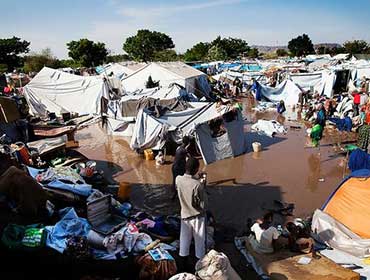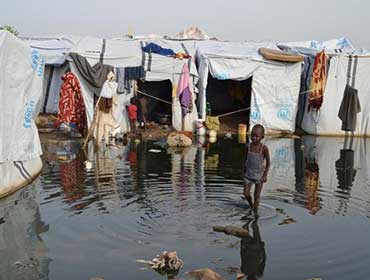A lunar landscape, cracked earth, and scorching heat. 4,000 rudimentary tents made from wooden poles and plastic sheeting. And people everywhere, 95% of them women and children, according to camp authorities, and a few men, hoping at least to find safety and security, and perhaps even to make a first step towards a new life. It’s another day at one of the refugee camps where Médecins Sans Frontiéres (MSF) is working in Ethiopia, and “home” to thousands of South Sudanese people fleeing the latest wave of violence in their country. Any day now the rainy season will begin, bringing floods, and creating endless breeding sites for mosquitoes, and with them a new spike in malaria.
 Refugees are given insecticide treated bednets, but the shelter conditions are so poor that they’re using the nets as doors to their tents, to provide a modicum of privacy for the 7-10 people living inside.The population is not immunologically naive to malaria: the disease is endemic in the parts of South Sudan where they come from. Still, over one-third of camp residents are children under 5, the group most vulnerable to severe malaria—especially the 7-9% who are severely malnourished. The health of people in the camps is generally poor; many have been walking—sometimes for weeks—fleeing war, with little food or water, and no medical care along the way. Any disease in weakened people will have increased mortality; diarrhea, measles, pneumonia, and of course, malaria, all take a terrible toll.
Refugees are given insecticide treated bednets, but the shelter conditions are so poor that they’re using the nets as doors to their tents, to provide a modicum of privacy for the 7-10 people living inside.The population is not immunologically naive to malaria: the disease is endemic in the parts of South Sudan where they come from. Still, over one-third of camp residents are children under 5, the group most vulnerable to severe malaria—especially the 7-9% who are severely malnourished. The health of people in the camps is generally poor; many have been walking—sometimes for weeks—fleeing war, with little food or water, and no medical care along the way. Any disease in weakened people will have increased mortality; diarrhea, measles, pneumonia, and of course, malaria, all take a terrible toll.
What can be done beyond just waiting for malaria to sweep in and then treating people who become ill, as MSF and other aid organizations are now doing? We now have tools—from weather monitoring to close surveillance of new cases—to predict the onset of a malaria peak and a large proportion of severe cases, so shouldn’t we be taking more aggressive preventive measures?
One of the newest strategies in malaria control is Seasonal Malaria Chemoprevention (SMC), an effective approach in areas where at least 60% of annual malaria cases occur within four consecutive months or less. The idea is simple: once a month, children from ages 3-59 months are given a three day regimen of the anti-malarials Sulphadoxine/Pyrimethamine (SP) (taken on the first day of each cycle) and Amodiaquine (AQ) (days 1, 2 and 3). This simple regimen provides protection from clinical malaria for about one month, and is repeated for 3-4 months until the seasonal peak is over. We and others have seen more than a two thirds reduction in cases of both uncomplicated and severe malaria in areas where SMC has been implemented.
When MSF started implementing SMC in 2012 in Mali and Chad, managers of countries like Democratic Republic Congo and Central African Republic immediately started requesting similar interventions. However, both these countries have not only seasonal peaks but also high transmission of malaria year round, a context for which effective SMC like approaches haven’t yet been developed.
The Ethiopian context presents additional challenges to both malaria chemoprevention (MC) and to more traditional preventive approaches. For starters, the choice of preventive drugs is a difficult one. In Ethiopia there is a high level of resistance to SP, while AQ is not registered in-country and some AQ resistance may also be present (since high levels of resistance to chloroquine—as assessed by molecular markers, which are also a proxy for AQ resistance—are documented).
However, SP may nevertheless be useful, since it has shown protective efficacy when used by pregnant women even in areas with high levels of resistance—and could potentially still work in other populations/groups. Mefloquine, another anti-malarial, is protective in infants and pregnant women, although it has side effects that can be difficult to tolerate. Another alternative could be artemisinin combination therapies (ACT); however, artemisinins are now the best drugs for treatment, and without close monitoring of intake during the three day MC regimen, there is a potential risk of developing resistance. So the bottom line is that there is no optimal drug, highlighting the challenges of designing an appropriate chemoprevention strategy for this context—yet leaving the sense that it’s essential to make some trade-offs and devise the best possible strategy with the limited tools at hand.
 At the same time, strengthening other preventive approaches is essential. A new distribution of bednets will be needed, accompanied by more communication to improve uptake and proper use. Other mainstays of prevention measures in stable settings are more problematic in emergencies: Housing conditions in refugee camps are not optimal for indoor residual spraying, and impregnated plastic sheeting is not currently being distributed, but could be explored going forward. Other methods of vector control might also be feasible: for example, since the camps will soon be surrounded by flood plains, larviciding may be an option.
At the same time, strengthening other preventive approaches is essential. A new distribution of bednets will be needed, accompanied by more communication to improve uptake and proper use. Other mainstays of prevention measures in stable settings are more problematic in emergencies: Housing conditions in refugee camps are not optimal for indoor residual spraying, and impregnated plastic sheeting is not currently being distributed, but could be explored going forward. Other methods of vector control might also be feasible: for example, since the camps will soon be surrounded by flood plains, larviciding may be an option.
In any case, waiting for a high case load, which will include many children needing transfusions yet with only limited blood availability (since voluntary blood donation is not common practice) hardly seems like the best option. MSF is currently working with partners in countries where we provide healthcare to large numbers of refugees or displaced persons, to devise feasible prevention strategies. If successful, these could be part of a package of preventive activities for displaced populations arriving in malaria endemic areas. However, as the rain approaches in Ethiopia, so does malaria, and it may already be too late to implement solutions for the start of the anticipated long malaria season ahead.
Photo 1 credit: Anna Surinyach/MSF.
Photo 2 credit: Aurelie Baumel/MSF.
Both photos show flooding in a South Sudanese refugee camp, where the rainy season has already begun.
Estrella Lasry is a New York based tropical medicine advisor for MSF.
